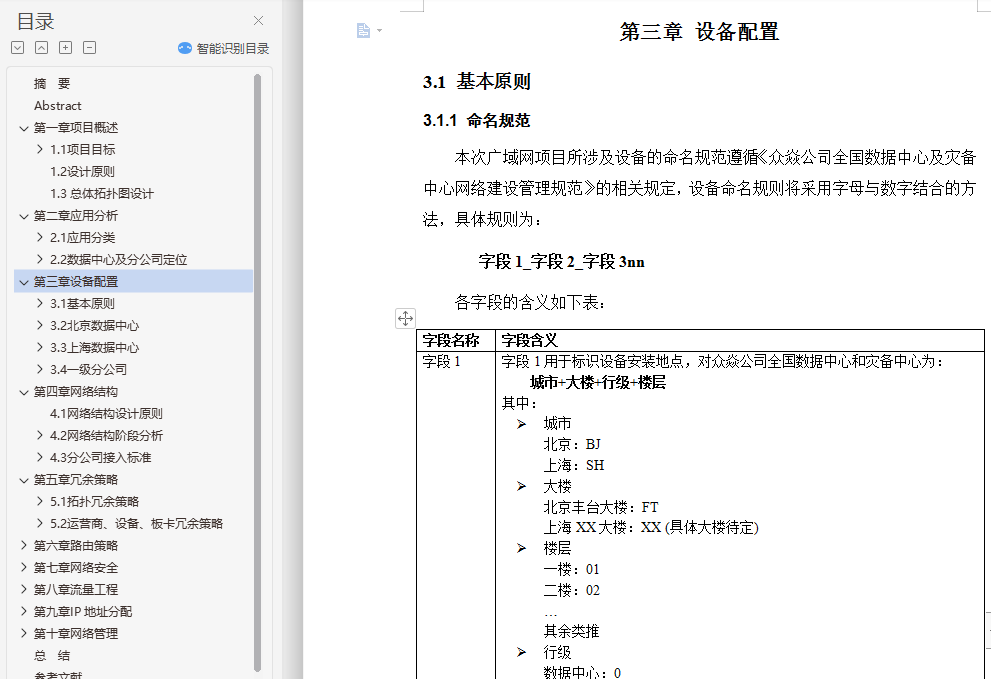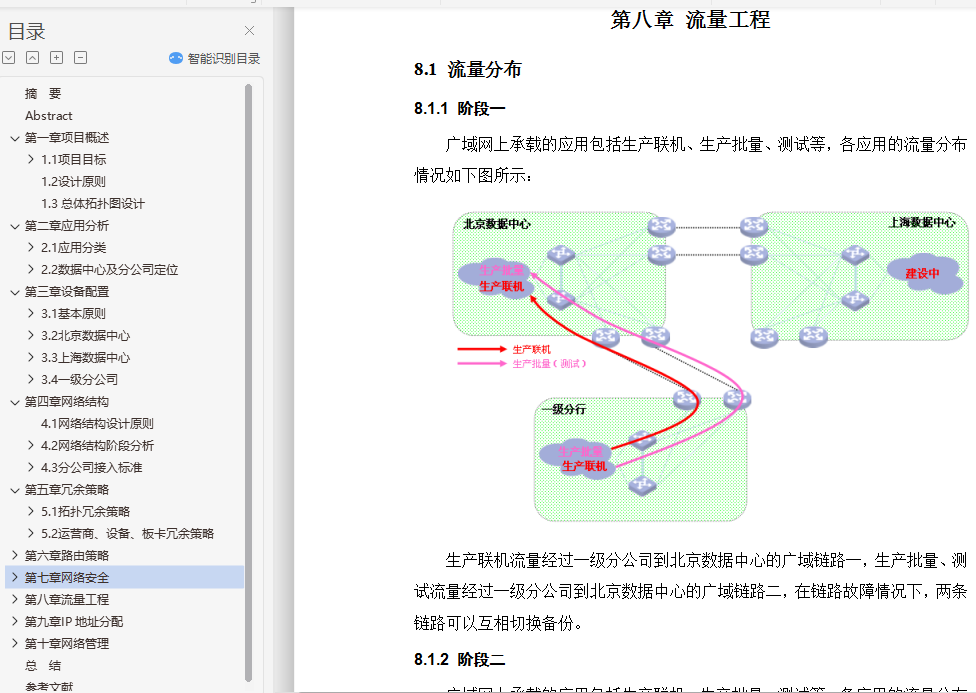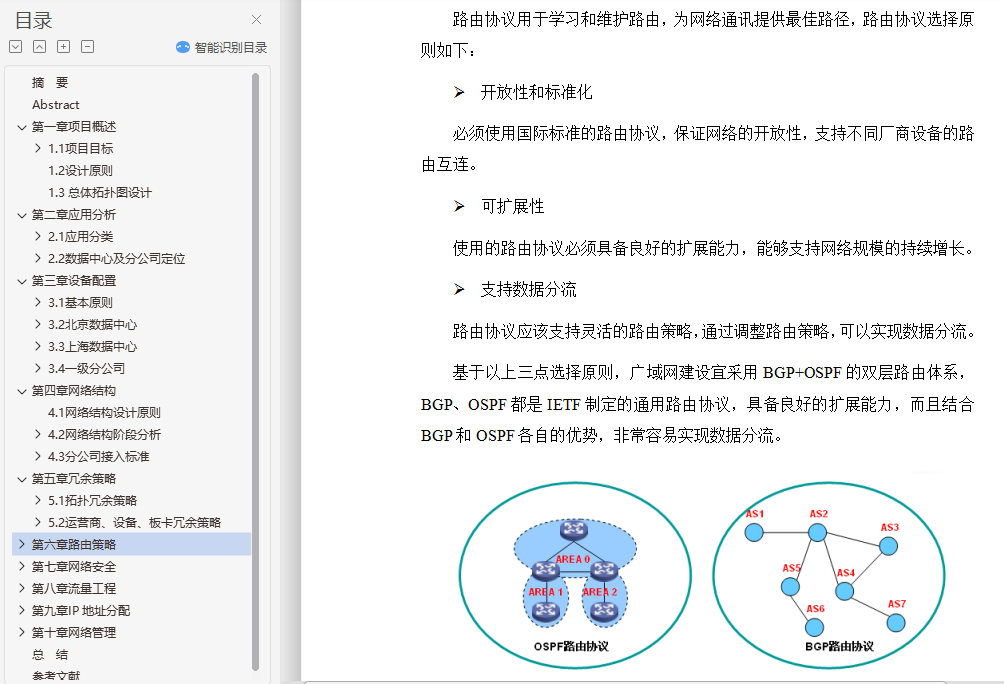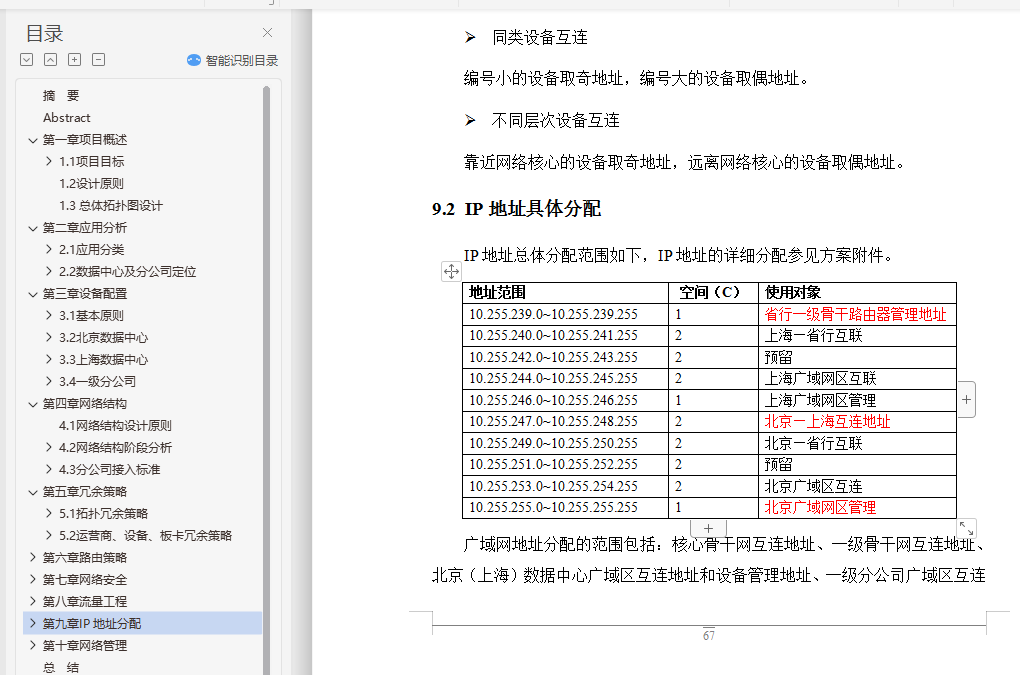摘 要
公司网络平台建设是一个非常庞大而复杂的系统,它不仅为企业现代化、综合信息管理和办公自动化等一系列应用提供基本操作平台,而且能提供多种应用服务,使信息能及时、准确地传送给各个系统。全网提供了一个中小型企业的局域网的解决方案,从水平方向按照核心层、汇聚层和接入层的思科层次架构来设计。本方案中核心层拥有9个路由器,汇聚层采用4个三层交换机,接入层每个三层交换机接有4台二层交换机,每个接入层接有4个虚拟局域网(Vlan)。其中核心层采用的是由思科公司专有研发的、性能优越、收敛速度快的增强内部网关路由选择协议(EIGRP)来实现核心层的快速转发功能,方案中采用A类地址15.0.0.0的变长子网规划(VLSM)全网。
关键词:路由器;三层交换机;虚拟局域网;增强内部网关路由选择协议;变长子网规划
Abstract
The construction of company network platform is a very large and complex system. It not only provides a basic operating platform for a series of applications, such as enterprise modernization, comprehensive information management and office automation, but also provides a variety of application services. So that the information can be timely and accurate transmission to the various systems. The whole network provides a LAN solution for small and medium-sized enterprises, which is designed horizontally according to the Cisco hierarchy of core layer, convergence layer and access layer. In this scheme, there are 9 routers in the core layer, 4 layer 3 switches are used in the convergence layer, 4 layer 2 switches are connected to each layer 3 switch in the access layer, and 4 virtual switches are connected to each access layer. Local area network (Vlan). The core layer is developed by Cisco, which has excellent performance and fast convergence speed. The core layer adopts the enhanced internal gateway routing protocol (EIGRP) to realize the fast forwarding function of the core layer. In the scheme, the variable length subnet with a class A address of 15.0.0.0 is used to plan the whole (VLSM) network.
Keywords: router; layer 3 switch; virtual local area network; enhanced internal gateway routing protocol; variable length subnet planning
目 录
摘 要 I
Abstract II
第一章 项目概述 1
1.1 项目目标 1
1.1.1 总体目标 1
1.1.2 阶段目标 1
1.2 设计原则 2
1.3总体拓扑图设计 3
第二章 应用分析 4
2.1 应用分类 4
2.1.1 应用系统总体框架 4
2.1.2 业务系统应用分类 5
2.1.3 信息管理系统应用分类 6
2.2 数据中心及分公司定位 7
2.2.1 阶段一 7
2.2.2 阶段二 7
2.2.3 阶段三 8
第三章 设备配置 9
3.1 基本原则 9
3.1.1 命名规范 9
3.1.2 端口分配 10
3.2 北京数据中心 11
3.2.1 设备配置 11
3.2.2 端口分配 11
3.3 上海数据中心 12
3.3.1 设备配置 12
3.3.2 端口分配 12
3.4 一级分公司 12
3.4.1 设备配置 12
3.4.2 端口分配 13
第四章 网络结构 14
4.1 网络结构设计原则 14
4.2 网络结构阶段分析 14
4.2.1 阶段一 14
4.2.2 阶段二 16
4.2.3 阶段三 18
4.3 分公司接入标准 19
4.3.1 阶段一 19
4.3.2 阶段二 20
4.3.3 阶段三 20
第五章 冗余策略 22
5.1 拓扑冗余策略 22
5.1.1 拓扑冗余策略设计原则 22
5.1.2 拓扑冗余策略(阶段一) 22
5.1.3 拓扑冗余策略(阶段二) 24
5.1.4 拓扑冗余策略(阶段三) 26
5.2 运营商、设备、板卡冗余策略 29
5.2.1 运营商、设备、板卡冗余策略设计原则 29
5.2.2 运营商、设备、板卡冗余策略阶段一、二、三(核心骨干网) 29
5.2.3 运营商、设备、板卡冗余策略阶段一、二(一级骨干网) 31
5.2.4 运营商、设备、板卡冗余策略阶段三(一级骨干网) 32
第六章 路由策略 36
6.1 路由总体规划 36
6.1.1 路由协议选择 36
6.1.2 路由协议部署(阶段一、二) 37
6.1.3 路由协议部署(阶段三) 38
6.2 广域网路由策略 40
6.2.1 阶段一、二 40
6.2.2 阶段三 42
6.3 广域区路由策略 45
6.3.1 阶段一、二 45
6.3.2 阶段三 48
6.4 局域网路由策略 52
6.4.1 阶段一、二 52
6.4.2 阶段三 53
第七章 流量工程 54
7.1 流量分布 54
7.1.1 阶段一 54
7.1.2 阶段二 54
7.1.3 阶段三 55
7.2 QoS策略 56
7.2.1 总体策略 56
7.2.2 阶段一、二 58
7.2.3 阶段三 59
第八章 网络安全 61
8.1 网络安全原则 61
8.2 设备安全 61
8.3 业务安全 64
8.3.1 阶段一、二 64
8.3.2 阶段三 65
第九章 IP地址分配 67
9.1 IP地址分配原则 67
9.2 IP地址具体分配 67
第十章 网络管理 70
10.1 网管系统选择 70
10.1.1 选择原则 70
10.1.2 网元管理软件 70
10.2 网管系统部署 71
总 结 73
参考文献 74










